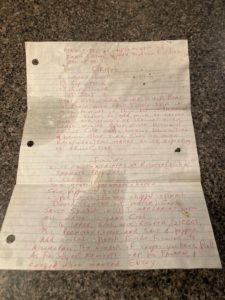Mondays with Mike: And the Oscar goes to…
March 28, 2022 • 4 Comments • Posted in Mike Knezovich, Mondays with MikeAll the talk today in the wake of last Night’s Academy Awards show seems to be about Will Smith slapping Chris Rock. I’ll be honest—in real time I thought it might have been a bit that was supposed to be funny that went bad. But apparently not. (I also completely missed the Janet Jackson wardrobe malfunction in real-time, too. I think I was the better for it.)
Anyway, I’ve pretty much always tuned into the Oscars—it started when I was a kid and it was a family event. I used to see a lot more movies than I do now. for one thing, it’s a part-time job to sort out which movie is streamed from what service. And to get them all you’re essentially paying another cable bill. For another, the real-thing big-screen in-person experience is clogged with superheroes and CGI-ed comics. That and animation. I hate animation. Just do.
Usually, somehow, Beth and I have seen one or two nominated films but this time, zilch. So the awards were sort of a way of figuring out which we’d want to bother with (which is its purpose, after all).
The Smith-Rock incident really didn’t and doesn’t matter much to me. Two other things stuck, though. One was a gag by Regina Hall that kind of went sideways in two ways. First, she said she needed to do covid tests, which is sort of unfunny at its face. Then she asked for “volunteers” to be tested, but called up only hunky and-or dreamy men. What followed flunked on all fronts, mostly because it was just not funny. (And apparently lots of others thought this was weird, too.)
But the thing that struck me, being of a certain age, is that it was the sort of bit that I would have seen on the 60s Johnny Carson Tonight Show, or the Dean Martin show—and would be considered wholly inappropriate today. I distinctly remember a Dean Martin show where Raquel Welch was the guest star. In one skit, Martin played a doctor, and when a man came in saying he wasn’t feeling well, Martin’s doctor told the patient to go home and take an aspirin. Then Welch’s character came in and said she wasn’t feeling well. Martin told her to go in the exam room and take off all her clothes. Pretty sure that wouldn’t fly today.
I’m not particularly offended by last night or Dean Martin, save for it being sort of juvenile. But flip last night’s script to have a male host call up attractive Hollywood women, then frisk them, and, ooh boy. Will Smith and Chris Rock are an afterthought. Mostly, I don’t care, but I think it does beg questions about whether sexist, exploitative jokes cut both ways.
I’ll probably not remember any of it after a couple of days. One thing I will remember, as long as I have the capacity to remember, is when Troy Kotsur became the first deaf man to win an acting Oscar. Beth usually doesn’t stay up late, and typically she would’ve been asleep by the time that award was handed out. But in her part-time role as blog coordinator for Easterseals, which supports people with disabilities, she had a professional interest. (Indeed, it provided fodder for a post at the Easterseals blog.)
When Troy Kotsur was announced as the winner, I heard weeping. I looked and Beth was in full blown tears of joy and tears of relief. It took me, who has lived with Beth for nearly 38 years—37 of which after she lost her sight, completely by surprise.
But it shouldn’t have. For all the discussion about equality and equity, it mostly focuses on gender and skin color. Rarely is disability included.
For as long as she’s been blind, Beth has resolved to educate and advocate for people by leading as full a life as possible. To advocate by example. But that’s really freakin’ hard. On one hand, she feels the need to impress the idea that she can do anything sighted people can do. On the other, it’s not the same—and most things are harder.
In that glorious moment, I felt, deeply, something that I had always grasped intellectually. But I didn’t, until that moment, get how it felt.
Beth called our friend, who is married to a deaf man and is a sign-language interpreter, to share her joy—and our friend was also in tears. Of course, I couldn’t keep it together at this point either.
Beth went to bed and I was up alone when CODA won for Best Movie. And it happened again.




